#glycemic index wheat
Text

unbelievably easy plant-based meal #4: harissa sweet potato & cucumber salad pitas
does this photograph well? not really! but is it unbelievably delicious and almost criminally easy to prepare? yes x 10000!!! this is an old hello fresh recipe that my bff liz recently made for me and it is soooo good and so low effort.
what you need: one sweet potato, one cucumber, some plain Greek yogurt or mayo, dill if you like it, white wine vinegar, whole wheat pita pockets (my store didn’t have pockets so I’m just doing pitas), and harissa (kinda hard to find sometimes but you can buy a giant thing of it on amazon)
what you do:
preheat the oven to 450. chop the cucumber and the sweet potato into half moons that are like… idk… a quarter inch thick. put the sweet potatoes only on a baking sheet, drizzle with olive oil, sprinkle with salt pepper and harissa, and pop it in the oven for 18-20 min.
put the chopped cucumber into a bowl. dump in some white wine vinegar (doesn’t have to be a ton but you’re gonna let the cucumbers kinda marinate in there while the sweet potatoes cook. add a little olive oil, salt and pepper, and some chopped dill if you like it.
make your sauce in a small bowl—the tastiest combo is mayo + garlic + salt pepper + lots of harissa, but I sometimes do plain Greek yogurt instead because I like the tanginess of the yogurt and it’s a bit healthier. both good! once I’ve done this step I usually pause to clean up everything else (it’s minimal mess).
when the potatoes are close, lightly toast your whole wheat pitas and get stuff ready.
enjoy!!! keeps well in the fridge for a couple days too—just cover or wrap everything and then you can pop the sweet potatoes in the microwave & toast a new pita for lunch.
additional thoughts:
this one is fun because it’s INTERACTIVE (you get to make your own pita with your desired proportions) and it’s virtually no prep apart from easy slicing and a little mixing.
clean up is super easy especially if you use foil on your baking sheet and clean up as you go
#for portion sizes I usually do one pita piled high with stuff & cut in half#but you do you it’s very yummy#i do recommend whole wheat pita over white/regular pita though#i think it’s tastier and it’ll keep you full longer#more fiber + a lower glycemic index value which is good if you have pcos or are watching blood sugar#recipe book tag#unbelievably easy plant based meals#food
16 notes
·
View notes
Text
Mum saw others eating this Cellophane/Glass Noodles (冬粉) at Chong Pang Food Centre, so she bought it for me to try. The portion was huge and came with both pork and fish balls in addition to minced pork, fish dumpling and fishcake slices. The transparent noodle is made from starch (such as mung bean starch, potato starch, sweet potato starch, tapioca, or canna starch) and water. Glass noodles are healthier than rice or wheat noodles because it contains less carbs and also lower in glycemic index.


#Cellophane Noodles#Glass Noodles#冬粉#粉丝#粉条#Takeaway#Packed#Chong Pang Food Centre#Meat Ball#Fish Ball#Mince Pork#Fish Dumpling#Fishcake#Pork Lard#Healthier#Breakfast#Food#Buffetlicious
16 notes
·
View notes
Text
Peanuts: A nutrient-rich and versatile snack with many health benefits

Peanuts are a type of legume that is native to South America. They are one of the most popular snack foods in the world, and for good reason. Peanuts are packed with nutrients and have been linked to a number of health benefits.
**Nutritional value of peanuts:**
Peanuts are a good source of:
* Protein: Peanuts are a good plant-based source of protein, making them a good choice for vegetarians and vegans. One ounce of peanuts contains approximately 6 grams of protein.
* Healthy fats: Peanuts contain mostly monounsaturated and polyunsaturated fats, which are good for heart health. Monounsaturated fats can help to lower LDL (bad) cholesterol levels and raise HDL (good) cholesterol levels. Polyunsaturated fats can also help to lower LDL cholesterol levels.
* Fiber: Peanuts are a good source of fiber, which can help to keep you feeling full and satisfied. Fiber can also help to improve digestion and regularity. One ounce of peanuts contains approximately 3 grams of fiber.
* Vitamins and minerals: Peanuts contain a variety of vitamins and minerals, including vitamin E, magnesium, potassium, and niacin. Vitamin E is an antioxidant that can help to protect cells from damage. Magnesium is important for muscle and nerve function. Potassium is important for blood pressure regulation. Niacin is important for energy metabolism and skin health.
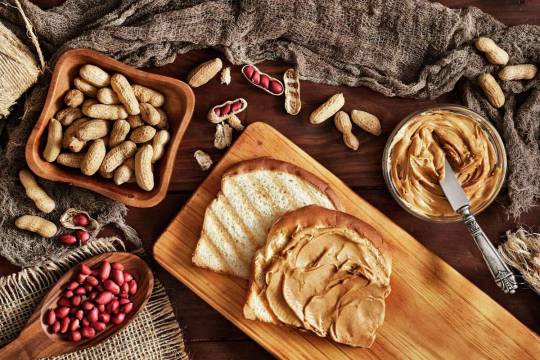
**Health benefits of peanuts:**
Peanuts have been linked to a number of health benefits, including:
* Reduced risk of heart disease: The healthy fats and antioxidants in peanuts can help to lower cholesterol levels and improve blood vessel health. A study published in the journal *Circulation* found that people who ate peanuts or peanut butter at least five times per week had a 14% lower risk of death from heart disease than those who did not eat peanuts or peanut butter.
* Improved blood sugar control: Peanuts have a low glycemic index, meaning they do not cause a rapid spike in blood sugar levels. This makes them a good snack option for people with diabetes or prediabetes. A study published in the journal *Diabetes Care* found that people with type 2 diabetes who ate peanuts or peanut butter as part of a healthy diet had lower blood sugar levels and less insulin resistance than those who did not eat peanuts or peanut butter.
* Weight management: Peanuts are high in protein and fiber, both of which can help you to feel full and satisfied. This can lead to reduced calorie intake and weight loss over time. A study published in the journal *Obesity* found that people who ate peanuts or peanut butter as part of a low-calorie diet lost more weight and body fat than those who did not eat peanuts or peanut butter.
* Cancer prevention: Some research suggests that peanuts may help to protect against certain types of cancer, such as colon cancer and breast cancer. A study published in the journal *Cancer Epidemiology, Biomarkers & Prevention* found that people who ate peanuts or peanut butter at least twice per week had a 27% lower risk of developing colon cancer than those who did not eat peanuts or peanut butter. A study published in the journal *Breast Cancer Research and Treatment* found that women who ate peanuts or peanut butter at least five times per week had a 22% lower risk of developing breast cancer than those who did not eat peanuts or peanut butter.
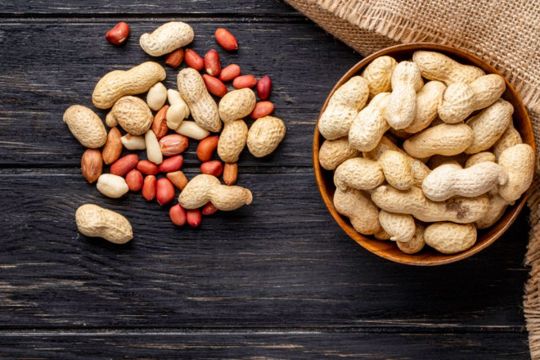
**How to incorporate peanuts into your diet:**
Peanuts can be eaten raw, roasted, or salted. They can also be used to make peanut butter, peanut oil, and other peanut products. Peanuts can be incorporated into a variety of dishes, including salads, soups, stews, and stir-fries.
Here are some tips for incorporating peanuts into your diet:
* Add a handful of peanuts to your breakfast cereal, oatmeal, or yogurt.
* Spread peanut butter on whole-wheat bread or crackers for a healthy snack or sandwich.
* Add peanuts to salads, soups, stews, and stir-fries.
* Snack on peanuts instead of unhealthy snacks like chips or candy.
* Make your own peanut butter at home using raw peanuts and a blender.
**Conclusion:**
Peanuts are a nutritious and versatile snack food with many health benefits. They are a good source of protein, healthy fats, fiber, and vitamins and minerals. Peanuts have been linked to a number of health benefits, including reduced risk of heart disease, improved blood sugar control, weight management, and cancer prevention. Peanuts can be easily incorporated into a variety of dishes, making them a healthy and convenient food choice for everyone.
#healthy#health#help#healthcare#headlines today news#headline news#self healing#heartbreak#healthy diet#business news#breaking news#blog#latest news#natural remedy#nutritious#world news#nature#news#money#beautiful#beauty#low cal diet#weight loss diet#life#love#long reads#liveblogging#literature#journal#gorgeous
3 notes
·
View notes
Text
White-flour bread; French state destruction of wheat biodiversity, food-making traditions, and bread variations; corporate/neoliberal recuperation and institutionalization of so-called “artisanal” breads
-------
Though the milling industry had already become big and powerful by then, after WWII in France (and elsewhere in Europe) the various links in the industrial chain came together to form a giant bread business. Along with implementing land reforms, the French state slowly limited the wide variety of available wheats to a selection of “modern” ones; the only varieties to be sold after 1949 were more resistant to lodging and guaranteed high yields when spayed with the right pesticides and fertilizers. Modern wheats were also selected for their baking strength. [...] Since kneading had come to be done by big machines instead of human hands, high baking strength was necessary for producing loaves attractive to consumers. [...] In the 1950s, French wheat fields expanded in size to produce the right raw materials for this new milling industry. [...] The less bran, the poorer the flour is in fiber and minerals. To compensate for the nutritional loss from the chemically induced whitening process, the milling industry started to enrich flours [...]. In fact, when bread first became a commodity, white bread was always trendier than browner bread. It’s a class thing: historically, white bread was traditionally for rich people because it was thought to demonstrate the “cleanliness” and “purity” of the flour. This fallacy was reproduced with industrial bread production, and so shitty industrial white flour started to flood the market.
-------
After the milling industry came the baking industry. In the postwar period, bread-making companies began to use a wide array of baking improvers while also over-kneading the dough to oxidize it so it would whiten further. In this situation, bread-making no longer depends on its environment: in dry or humid weather the recipe remains unchanged. Bread is no longer alive; it has become a machine, just like the baker. In bread factories, flours only need two hours to become bread, rather than the typical twenty-four.
Like most of the food we consume in the West, bread became rationalized. And hyper-leavened, innutritious, high-glycemic-index white bread took over supermarket shelves.
Efficiency above all else, at the cost of quality, respect, and pleasure.
The bread industry could have continued in this direction and thrived. Instead, in a quintessential neoliberal move, it co-opted a smaller “mom-and-pop” industry, adding a new link to its corporate chain. It all began in 1998 when the French government passed the May 25 Law, probably under pressure from small bakers afraid of disappearing due to supermarket competition. The law established a strict definition for what it means to be an “artisan” baker. [...]
But, as is often the case with state intervention, the public was misled [...]. The story of institutionalizing “artisan” bread production in France is really the story of corporate recuperation and consolidation.
The food-processing giant Vivescia (3.1 billion euros total revenue in 2021) now controls much of the artisan-bread value chain; it owns the second largest grain cooperative in Europe, and its brand Francine is a huge player in the milling industry (covering 32 percent of all-purpose flour market in France in 2018). Since the May 25 Law, Vivescia has also absorbed fifteen thousand artisanal bakeries into its affiliate chain Campaillette, forcing subsidiaries to follow standardized recipes and to use Vivescia-produced ingredients, turning bakers into mere machines. In 2015, an amendment to the 1998 law guaranteed the production of unhealthy bread in artisanal bakeries by introducing the requirement that artisan bakers hold a special degree (Certificat d’Aptitute Profesionnelle, or CAP). This new requirement systematizes the learning of “traditional” bread making recipes that rely exclusively on chemical yeast and near-white flours. As a result, many artisan bakers wake up in the middle of the night to combine water and ready-made mixes, breathing in industrial flour and baking improvers that trigger asthma and pollute their lungs [...].
-------
Text by: Alix Guibert. “We Will Lack Bread No Longer.” e-flux journal #128. June 2022. [Italicized first paragraph/heading added by me.]
74 notes
·
View notes
Text
Is Sourdough Bread Good for Weight Loss? - A Healthier Choice
Sourdough bread, a staple in many cultures for centuries, has recently seen a resurgence in popularity. But beyond its unique taste and texture, there’s growing interest in its potential health benefits, particularly regarding weight loss. This report delves into the making of sourdough, its health and fermentation benefits, nutritional profile, and expert opinions to answer the question: Is sourdough bread good for weight loss?
Tea Burn™ Breakthrough in Weight Loss Support
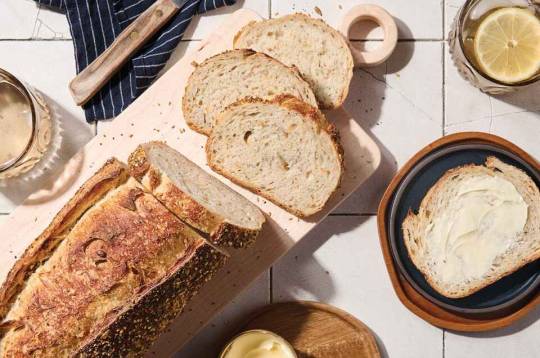
Making of Sourdough
Sourdough’s simplicity is one of its key attractions. Traditionally, it’s made from just three ingredients: flour, water, and salt. This simplicity is a stark contrast to many commercially produced breads that contain a plethora of additives. The slow fermentation process of sourdough, where natural yeasts and bacteria interact with the dough, is what sets it apart. This process not only imparts a distinct tangy flavor but also influences the bread’s health properties.
Odd Water Secret Melts Stubborn Fat
Sourdough Health Benefits
Sourdough’s health benefits are closely tied to its fermentation process. Priya Tew, an award-winning dietitian, explains, “Genuine sourdough bread can be more easily digested and can be lower in glycemic index than some shop-bought bread.” This lower glycemic index means sourdough doesn’t spike blood sugar levels as sharply as other breads, which is a crucial factor in weight management.
Gut Health: The fermentation process increases prebiotic and probiotic-like properties, which can improve gut health. Sourdough made with whole grains offers additional fiber, enhancing these gut-friendly benefits.
Digestion: Sourdough might improve the digestion of gluten due to changes in wheat enzymes during fermentation. While not suitable for people with celiac disease, those sensitive to gluten might find sourdough easier to digest.
Healthy Aging: Sourdough, a staple in the Mediterranean diet, is linked to healthy aging. It has antioxidant, anti-hypertensive, anti-diabetic, and FODMAP-reducing qualities.
Shrink X™ Powerful Pet Probiotic Formula
Sourdough Fermentation Benefits:
The fermentation process in sourdough bread leads to an increase in prebiotic and probiotic-like properties, which are beneficial for gut health. A 2021 review in the journal Microorganisms highlights this, noting that these properties help improve gut health. Additionally, the fermentation process enhances the bioavailability of nutrients like calcium, phosphorus, and iron, making them more accessible to the body.
Nutritional Profile:
A slice of sourdough bread typically contains about 84 calories, 16 grams of carbohydrates, 1 gram of fiber, 3 grams of protein, and 1 gram of total fat. Laura Tilt, a registered dietitian, points out, “White sourdough is a source of carbohydrates, calcium, iron, vitamin B1, and B3, forming part of a healthy diet.” However, she advises opting for wholewheat varieties for higher fiber content.
Facts about Sourdough Bread
Historical Popularity Surge: Sourdough’s recent popularity isn’t just a modern trend. Its global market value skyrocketed from $298.7 million to a staggering $2.4 billion in 2018. This surge reflects a growing awareness and appreciation of sourdough’s unique qualities and health benefits.
Enhanced Taste with Health Benefits: The fermentation process in sourdough not only contributes to its health benefits but also enhances its taste. Priya Tew notes that fermentation produces amino acids that add extra flavor, despite a decreased salt content in the bread. This means you get a tasty bread that’s also good for you.
B12 Enrichment: The fermentation of plant-based foods like sourdough can lead to the enrichment of vitamin B12. This is particularly noteworthy since B12 is typically associated with animal-based foods, making sourdough a valuable addition to vegetarian diets.
Impact on Blood Sugar Levels: Sourdough bread’s fermentation process results in a lower glycemic index compared to regular bread. This means it has a less dramatic impact on blood sugar levels, making it a smarter choice for those managing diabetes or looking to maintain stable energy levels throughout the day.
Variety in Sourdough Types: The diversity of sourdough bread is vast. From traditional white sourdough to wholewheat and rye varieties, each type offers different nutritional benefits. For instance, rye sourdough is known for its higher fiber content, while traditional white sourdough is fortified with essential vitamins and minerals.
Expert Opinion of Sourdough Bread on Weight Loss:
Experts agree that sourdough can be part of a weight loss diet. Tilt reminds us, “All foods can be part of a weight loss diet; it’s about balance and portion size.” She suggests pairing sourdough with nutrient-dense foods like eggs or nut butter for a balanced meal. The high fiber content in sourdough, especially in wholegrain varieties, is linked to feeling full for longer, which is beneficial for weight management.
Promote Deep Sleep and Relaxation
FAQs around Is Sourdough Bread Good for Weight Loss?
Can sourdough bread help in weight loss?
Yes, sourdough bread can be part of a weight-loss diet. Its high fiber content, especially in wholegrain varieties, helps you feel full longer, which can aid in managing calorie intake.
Is sourdough bread lower in calories than regular bread?
Sourdough bread’s calorie content is comparable to many other types of bread. However, its nutritional composition, particularly its lower glycemic index, makes it a healthier choice that can fit into a weight loss diet.
Does sourdough bread cause blood sugar spikes?
Sourdough bread has a lower glycemic index compared to many other breads, meaning it causes a slower and less dramatic rise in blood sugar levels. This makes it a suitable option for those managing blood sugar levels.
Can I eat sourdough bread every day if I’m trying to lose weight?
Yes, you can include sourdough bread in your daily diet while trying to lose weight. Remember, balance and portion control are key. Pairing it with nutrient-dense foods can make your meals more satisfying and nutritionally balanced.
Is sourdough bread better than whole wheat bread for weight loss?
Sourdough and whole wheat breads each have their benefits. Sourdough’s fermentation process can make it easier to digest and lower in glycemic index, while whole wheat bread is typically higher in fiber. Your choice may depend on personal dietary needs and preferences.
Does the type of flour used in sourdough affect weight loss?
Yes, the type of flour affects the nutritional content of sourdough bread. Wholegrain flours are higher in fiber and nutrients compared to refined flours, making them a better choice for weight loss.
Is sourdough bread gluten-free?
No, traditional sourdough bread is not gluten-free as it is made from wheat flour. However, the fermentation process can break down some of the gluten, making it easier to digest for those with mild gluten sensitivities, but it is not suitable for individuals with celiac disease.
Life Extension GEROPROTECT Stem Cell
Sourdough bread, with its unique fermentation process and nutritional profile, offers several health benefits that can support weight loss goals. Its lower glycemic index, coupled with a higher fiber content, especially in wholegrain varieties, makes it a healthier choice compared to many other breads. While sourdough alone isn’t a magic bullet for weight loss, it can be a valuable part of a balanced and nutrient-rich diet. Variety and moderation are key to a healthy diet and effective weight management.
2 notes
·
View notes
Text
If you’re into the simple pleasures in life I implore you to experiment with PB&Js. There’s so many fucking variations. Peanut butter and grape jelly, peanut butter and strawberry jelly, of course. Peanut butter and banana. Peanut butter and honey. But you can combine this shit. Get sillay with it. Peanut butter and Nutella. Nutella and strawberry jam and honey. Hell, I found out that peanut butter and apricot jam and honey is fucking insane. And slap that shit on some oatnut bread for added nutrients and a decreased glycemic index. Peanut butter and banana on wheat bread is a GREAT meal for diabetics specifically. And there’s almond butter etc as well if you don’t like peanuts. Like even if you have an aversion to the taste and texture of vegetables, sandwiches can be so fun to specialize, as well as cheap and very filling and with the potential to be healthy. And like I’ve said before, if you’re in a mental health or neurodivergency situation in which an increased sense of control in your life would be highly beneficial, experimenting with simple cooking is a fantastic way to facilitate that.
65 notes
·
View notes
Text
The benefits of fonio are so marked that academics and policymakers are now calling for the grain – alongside other indigenous foods, such as Ethiopia’s teff, as well as cassava and various millets and legumes – to be embraced more widely across Africa to improve food security. ...
These ancient foods, with their greater nutritional benefits and resilience to drought, could break the continent’s reliance on imported wheat, rice and maize, which often do not grow easily in Africa but now dominate people’s diets. ...
Michel Ghanem, an agronomist who co-founded the Forgotten Crops Society, is calling for more investment in these neglected foods. ...
“You have lots of indigenous crops – like teff, fonio, sorghum – that people still eat today but have been neglected by funding agencies, the international research organisations, but definitely not by consumers. And it’s now that we should invest in these because they could close that [food] gap.”
Researchers say these neglected foods have several nutritional benefits, often with lower glycemic index ratings than refined flours and white rice, while also having important micronutrients. Research in the 1990s into neglected African crops by the US National Research Council found that fonio and finger millet were rich in the essential amino acid methionine, which is often lacking in western diets, while teff was high in protein, amino acids and iron. ...
Edie Mukiibi, vice-president of Slow Food International, which campaigns to protect threatened local food cultures, says imperialism imposed “monoculture” farming on Africa and other colonised regions of the world, destroying biodiversity in agriculture.
2 notes
·
View notes
Text
Top 5 foods to aid in weight loss
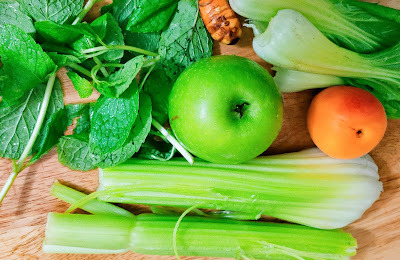
Leafy Greens:
Leafy greens such as spinach, kale, Swiss chard, and lettuce are excellent choices for weight loss. They are low in calories and high in fiber, which helps keep you feeling full for longer and reduces overall calorie intake. Additionally, leafy greens are packed with essential vitamins, minerals, and antioxidants that support overall health.
Lean Protein:
Incorporating lean protein sources into your diet can aid in weight loss. Foods like chicken breast, turkey, fish, tofu, and legumes are not only rich in protein but also help promote satiety and preserve muscle mass. Protein takes longer to digest, which means it keeps you feeling satisfied and helps to prevent overeating.
Whole Grains:
Opting for whole grains like quinoa, brown rice, oats, and whole wheat bread instead of refined grains can support weight loss efforts. Whole grains are rich in fiber, which aids in digestion and helps control hunger. They also provide essential nutrients and have a lower glycemic index, which helps regulate blood sugar levels.
Berries:
Berries, such as strawberries, blueberries, raspberries, and blackberries, are not only delicious but also beneficial for weight loss
#i wanna be weightless#i wanna lose weight#ana trigger#⭐️ving#4norexi4#bede motylkiem#ed bllog#ed disorder#ed not ed sheeran#jestem motylkiem#butterfly#Avatar
2 notes
·
View notes
Text
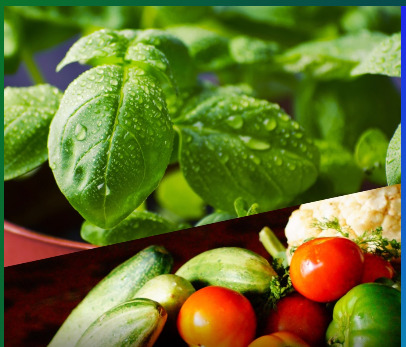
"Dietary Remedies for Candidiasis: Managing Yeast Infections through Healthy Eating"
Candidiasis, generally known as a incentive infection, is caused by an overgrowth of the Candida fungus in the body. While specifics are frequently specified to treat candidiasis, salutary changes can also play a significant part in managing the condition. In this composition, we will bandy colorful salutary remedies for candidiasis and how they can help palliate symptoms and promote overall health.
Reduce Sugar Intake Candida feeds on sugar, so it's pivotal to minimize your sugar consumption. Avoid meliorated sugars, including sticky potables, delicacies, goodies, and reused foods. Also, be aware of retired sugars in products like seasonings, gravies, and packaged snacks. conclude for natural sweeteners like stevia or small quantities of raw honey rather.https://rb.gy/mt8bj
Avoid High Glycemic Index Foods High glycemic indicator foods fleetly increase blood sugar situations, which can complicate candidiasis. Minimize or exclude consumption of white chuck , white rice, potatoes, and other refined carbohydrates. rather, choose whole grains like quinoa, brown rice, and whole wheat, which have a lower glycemic indicator.
Incorporate Antifungal Foods Certain foods retain antifungal parcels and can help combat Candida overgrowth. Include garlic, onion, coconut oil painting, gusto, turmeric, oregano, and cinnamon in your diet. These foods contain composites that can inhibit the growth of Candida and support the vulnerable system.
Consume Probiotic- Rich Foods Probiotics promote a healthy balance of gut bacteria and can inhibit the growth of Candida. Include fermented foods similar as yogurt, kefir, sauerkraut, kimchi, and kombucha in your diet. These foods give salutary bacteria like lactobacilli and bifidobacteria, which help restore the natural microbial balance in the body.https://rb.gy/mt8bj
Increase Fiber Input Fiber aids in digestion and helps exclude waste and poisons from the body, including Candida. Consume a variety of high- fiber foods like vegetables, fruits, whole grains, legumes, and nuts. These foods promote regular bowel movements, precluding the overgrowth of Candida in the gastrointestinal tract.
Stay Doused Drinking an acceptable quantum of water is essential for flushing out poisons and supporting overall health. Aim to drink at least eight spectacles of water daily to help maintain proper hydration and support your body's detoxification processes.
Limit Alcohol Consumption Alcohol can weaken the vulnerable system and contribute to Candida overgrowth. Minimize or avoid alcohol consumption, particularly beer and wine, which frequently contain high quantities of sugar that can fuel incentive growth.
Identify Food perceptivity Candidiasis can be associated with food perceptivity or disinclinations. Certain foods may spark inflammation and complicate symptoms. Consider keeping a food journal to identify any implicit food triggers and exclude them from your diet. Common lawbreakers include gluten, dairy, soy, and reused foods.
Support Liver Function The liver plays a pivotal part in detoxification. To support its function, incorporate liver-friendly foods similar as lush flora, cruciferous vegetables( broccoli, cauliflower, Brussels sprouts), beets, carrots, and failures. These foods contain antioxidants and nutrients that help cleanse the liver and aid in poison elimination.
Manage Stress habitual stress weakens the vulnerable system and disrupts the microbial balance in the body, making it more susceptible to Candida overgrowth. Practice stress- operation ways like contemplation, deep breathing exercises, yoga, or engaging in pursuits to promote overall well- being and reduce the threat of candidiasis.
Flash back, while salutary changes can be salutary, it's important to consult with a healthcare professional for a comprehensive treatment plan. They can give substantiated guidance and address any beginning health issues contributing to candidiasis.https://rb.gy/mt8bj
2 notes
·
View notes
Text
💗Allergens list💗
~~~~~~~~~~~~~~~~~~~~~~~
Disclaimer: Don’t come after me please.. I don’t have actual allergies but Im making them up to make sure I stay away from these foods.
~~~~~~~~~~~~~~~~~~~~~~~~~~~~~
🍞CARBS🍞
•••••••••••••
Packaged bread (White, rye and whole grain bread)
Why: contains L-cysteine (comes from human hair or pig,cow, and duck, which I can’t eat)
•••••••••••••••••
Rice
Why: has a high glycemic index, which make my blood sugar go up ( I’m actually pre-diabetic)
••••••••••••••••
Noodles
Why: gluten and wheat allergies
••••••••••••••••••
Cookies/ biscuits
Why: Allergic, causes rashes
••••••••••••
Apple cider donuts
Why: Apple allergy
••••••••••••••••
Oats
Why: allergic to gluten
••••••••••••••••••
Pizza ————————->
Pancakes
Muffins
Rice
Cupcakes
Tortillas. GLUTEN ALLERGYYY
Naan
Bagels
Pretzels
Chips/Crips
Puffs
Rice cakes ——————>
🥜🌰NUTS🌰🥜
============
Peanuts
Peanut butter/oil
Why: peanut allergies
=============
Cashew
Pistachio
Walnut
=========
Allergies!
===============
🍈🥝FRUIT🥝🍈
————————-
Watermelon
Apples
Oranges
Clementines
Peaches
Banana
Cantaloupe
Strawberries
Blueberries berries
Raspberries
Black berries
Cherries
pineapple
Mango
Grapes
Pear
Why: Severe allergic reaction to them. My throat will close up and I’ll have trouble breathing
————————————————————
🧁SUGAR🧁
****************
Brownies
Jelly
Pie
Cake
Biscuits
Cookies
Jam
Honey
Popsicles
Agave
************
Milk(all types)
Why: lactose intolerance and milk allergy
*********************
Yogurt(all types)
Why: lactose intolerance and milk allergy
***********************
Syrup
**********
Chocolate
Why: Cocoa Allergy
*******************
Gummies
Why: glycerin allergy
***********************
Sour candy
Lollies
*****************************
Sugar allergies in general
******************************
🥛🥚DAIRY🥚🥛
^^^^^^^^^^^^^
(More focused on dairy exactly)
Egg
Mayonnaise
Milk ( so almond and soy aren’t options bc I’m allergic)
Butter
Chocolate
Anything containing milk or eggs
Creamer
Cheese
Ice cream
Whipped cream
^^^^^^^^^^^^^^^
🍤🍖Meats🍖🍤
Fish
(Salmon,red snapper, flounder, tilapia) can’t eat any restaurant foods.
Shrimp
Crab
Scallop
Clam
Beef
Chicken
Lamb
Pork
Turkey
Any type of bacon or sausage
Not finished!!
#ana trigger#ed diet#skinnnny#calorie list#mal3sp0#model thin#skiny girl#skinnysp0#thinsbo#thinpii#thinppo#thinpiration#thinps0
8 notes
·
View notes
Text


unbelievably easy plant-based meal #2: colorful veggie scramble!
this one was a pandemic-era fave of mine. it’s an incredibly simple way to pack a TON of veggies in one meal (and you can customize it with whatever you have in the fridge). plus you get to feel very smug & virtuous all day because you ate sooooo many veggies for breakfast.
what you need: 4-6 eggs, half an onion, milk or plant-based milk, leafy greens (spinach or kale), and your favorite veggies (I used broccoli, cherry tomatoes, zucchini, and red + orange bell peppers for this one but have used carrots, mushrooms, asparagus, squash, cauliflower, corn… you name it, it’s delicious)
prep work: you gotta small dice the veggies but it’s easy to do the night before. I store the onions, veggies, and leafy greens separately since you’ll add them at different times.
what you do:
heat a dash of olive oil over medium high heat. when it’s sizzling toss in the diced onions, salt + pepper them, and cook 2-3 minutes until they start to soften.
add the veggie mix except the leafy greens. salt + pepper, then cook for 4-6 minutes or until softened. when the timer goes off add giant handfuls of greens (they cook down so much so you can add TONS) and cook for two more minutes or until the greens have wilted.
WHILE THE VEGGIES COOK: whisk your eggs in a bowl and add a dash of milk or water. once the spinach has wilted, pour the egg mixture into the bowl. salt + pepper again. let the eggs sit for a minute until they’ve started to set, then start gently folding in the edges to scramble the eggs a bit. this happens fast since the pan is so hot—usually the egg step takes 3-4 minutes max.
remove from heat and let sit for a minute (it’ll keep cooking a bit more. then serve with any garnishes or sauces you like (I usually do hot sauce). the leftovers will stay good in the fridge for about four days.
enjoy!!!
portion sizes: eat as much food as you want! but if you want to size your portions, I find 1 heaping cup of egg scramble (usually paired with a big handful of blueberries) fills me up, since the veggies have tons of fiber + the eggs have a lot of protein. but this is a good one to eat more of if you’re still hungry after your first bowl since it’s mostly veggies.
total time: 10 min to dice the veggies (can be prepped in advance), 10ish min to cook the veggies + eggs, and under 5 min to clean up if you put stuff away as you go.
fun additions:
literally any veggie works and it’s fun to try different combos. I try to make it as colorful as I can because it’s so pretty.
to get more protein: add white beans or tofu (or even substituting extra firm tofu for the eggs to make a tofu scramble).
to add whole grains (fiber + lower glycemic index value—good for PCOS): add a slice of whole wheat toast or make it a breakfast burrito by wrapping your scramble in a whole-wheat tortilla and adding your favorite salsa.
13 notes
·
View notes
Text
May aid blood sugar management
Fonio contains resistant starch, which resists digestion and absorption in your small intestine (5Trusted Source).
Resistant starches have many health benefits and may play a role in increasing insulin sensitivity and lowering blood sugar levels (21Trusted Source).
Furthermore, this grain has a low glycemic index (GI) score, meaning that it doesn’t quickly raise your blood sugar levels. For this reason, it may help people with diabetes manage their blood sugar (5Trusted Source).
3 notes
·
View notes
Text
Unlocking the Secret Health Benefits of Kodo Millet: A Superfood Sensation

Introduction
Kodo Millet, scientifically known as Paspalum scrobiculatum, is an ancient grain that has been cultivated in India for centuries. It belongs to the millet family and is known for its nutritional richness and health benefits.
Nutritional Profile
Kodo Millet is a powerhouse of essential nutrients. It is rich in carbohydrates, dietary fiber, protein, and various micronutrients such as iron, calcium, magnesium, and phosphorus. Additionally, it is gluten-free, making it an ideal choice for individuals with gluten intolerance or celiac disease.
Health Benefits of Kodo Millet
Digestive Health
The high fiber content in Kodo Millet promotes digestive health by preventing constipation, regulating bowel movements, and maintaining gut health. It also acts as a prebiotic, supporting the growth of beneficial gut bacteria.
Heart Health
Kodo Millet contains antioxidants and phytochemicals that help reduce the risk of cardiovascular diseases. It aids in lowering cholesterol levels, regulating blood pressure, and preventing the formation of arterial plaque.
Weight Management
Incorporating Kodo Millet into your diet can aid in weight management due to its high fiber content and low glycemic index. It promotes satiety, prevents overeating, and helps in controlling blood sugar levels.
Diabetes Management
The slow release of glucose from Kodo Millet helps in stabilizing blood sugar levels, making it a suitable grain for individuals with diabetes. It also improves insulin sensitivity, reducing the risk of insulin resistance.
Culinary Uses of Kodo Millet
Kodo Millet can be used in various culinary preparations, including porridge, pilaf, salads, soups, and baked goods. It has a mild nutty flavor and a fluffy texture, making it versatile for both sweet and savory dishes.
How to Incorporate Kodo Millet into Your Diet
There are numerous ways to incorporate Kodo Millet into your diet. You can replace rice or wheat with Kodo Millet in recipes such as biryani, pulao, or stir-fries. It can also be ground into flour for making rotis, dosas, or pancakes.
Sustainability and Environmental Impact
Kodo Millet is a sustainable crop that requires minimal water and can thrive in poor soil conditions. Its cultivation contributes to soil fertility and biodiversity conservation, making it an environmentally friendly choice.
Comparative Analysis: Kodo Millet vs. Other Grains
Compared to other grains like rice and wheat, Kodo Millet offers superior nutritional benefits and is more resilient to adverse growing conditions. It requires fewer pesticides and fertilizers, making it a more sustainable option.
Cultural Significance of Kodo Millet
Kodo Millet holds cultural significance in many regions of India, where it is celebrated in festivals and religious rituals. It is also used in traditional Ayurvedic medicine for its therapeutic properties.
Tips for Buying and Storing Kodo Millet
When purchasing Kodo Millet, look for organic and unprocessed varieties for maximum nutritional benefits. Store it in an airtight container in a cool, dry place to maintain its freshness and flavor.
Challenges and Misconceptions
Despite its numerous health benefits, Kodo Millet remains relatively unknown outside of certain regions. Lack of awareness and misconceptions about its taste and preparation methods pose challenges to its widespread adoption.
Research and Studies on Kodo Millet
Ongoing research and studies continue to uncover the potential health benefits of Kodo Millet, including its role in preventing chronic diseases, improving immune function, and promoting overall well-being.
Global Consumption Trends
As consumers become more health-conscious and environmentally aware, there is a growing interest in ancient grains like Kodo Millet. Its popularity is on the rise globally, with an increasing demand for nutritious and sustainable food options.
Future Prospects of Kodo Millet
With its exceptional nutritional profile, culinary versatility, and environmental sustainability, Kodo Millet is poised to become a staple ingredient in modern diets worldwide. Its promotion and cultivation hold promise for a healthier and more sustainable future.
Conclusion
Kodo Millet is not just a grain; it's a superfood sensation with incredible health benefits and culinary versatility. By unlocking its secret potential, we can nourish our bodies, support sustainable agriculture, and embrace a healthier lifestyle.
FAQs
Is Kodo Millet gluten-free?
Yes, Kodo Millet is naturally gluten-free, making it suitable for individuals with gluten intolerance.
How does Kodo Millet compare to other grains in terms of nutrition?
Kodo Millet is nutritionally superior to many other grains, offering higher levels of protein, fiber, and essential micronutrients.
Can Kodo Millet help in weight loss?
Yes, incorporating Kodo Millet into your diet can aid in weight management due to its high fiber content and low glycemic index.
Is Kodo Millet easy to cook?
Yes, Kodo Millet is easy to cook and can be used in a variety of culinary preparations, both sweet and savory.
Where can I buy Kodo Millet?
Kodo Millet is available at health food stores, specialty grocery stores, and online retailers
#KodoMillet#millets#millet#superfood#food#blog#social media#business#digital marketing#health#health & fitness
0 notes
Text
Why Should Millets Be a Part of Your Daily Life?

Madurai, a city steeped in history and culture, is also embracing a new wave of health consciousness. Millets, the ancient grains that are naturally gluten-free and packed with nutrients, are taking center stage. This informative guide explores the wonderful world of millets, their health benefits, and why you should incorporate them into your daily diet. We’ll also introduce you to Millet n Minutes Madurai, a fantastic online store for buying delicious and healthy millet snacks!
What are Millets?
Millets are a group of small-seeded cereal grains that have been cultivated for thousands of years. They are known for their resilience, thriving in harsh environments with minimal water. There are several types of millets, each with its unique taste and nutritional profile. Here’s a quick introduction to some of the most popular ones:
Finger Millet: This millet is rich in calcium, iron, and dietary fiber. It has a slightly sweet and nutty flavor and is often used in porridge, flatbreads, and even sweet dishes.
Foxtail Millet: This millet is easily digestible and has a slightly sweet, earthy taste. It cooks quickly and is perfect for making kheer, upma, and millet salads.
Kodo Millet: This millet is known for its protein content and is a good source of iron, calcium, and magnesium. It has a slightly bitter taste and is often used in savory dishes like millet pulao and stews.
Barnyard Millet: This millet is high in fiber and protein and has a slightly sweet and grassy flavor. It is a versatile grain used in khichdi, soups, and even millet pasta.
Proso Millet: This millet is known for its mild, nutty flavor and is a good source of phosphorus and B vitamins. It is often used in breakfast cereals, porridges, and millet cookies.
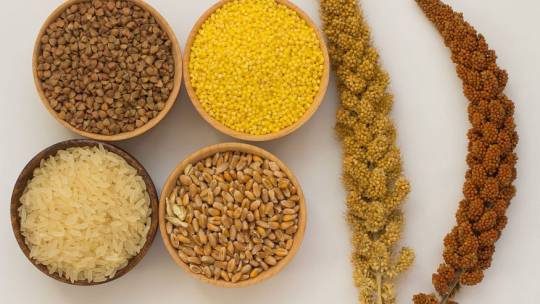
The Powerhouse of Health: Benefits of Millets
Millets are not just ancient grains, they are nutritional powerhouses! Here are some of the compelling reasons to include them in your daily diet:
Rich in Nutrients: Millets are a good source of protein, fiber, vitamins, and minerals. They are particularly high in iron, calcium, magnesium, and phosphorus, essential for maintaining good health.
Gluten-Free: Millets are naturally gluten-free, making them a perfect choice for individuals with celiac disease or gluten sensitivity.
High in Fiber: The high fiber content in millets keeps you feeling fuller for longer, aids in digestion, and helps regulate blood sugar levels.
Low Glycemic Index: Most millets have a low glycemic index, meaning they release sugar slowly into the bloodstream, preventing blood sugar spikes and crashes. This makes them beneficial for managing diabetes and promoting weight management.
Good for Heart Health: Millets are a good source of complex carbohydrates and healthy fats, which can help lower bad cholesterol levels and promote heart health.
Rich in Antioxidants: Millets contain antioxidants that help fight free radicals in the body and protect against chronic diseases.
Benefits of Millets :
With their impressive nutritional profile and numerous health benefits, millets deserve a prominent place in your daily diet. Here’s why:
Versatility: Millets are incredibly versatile grains. They can be cooked in various ways — boiled, steamed, roasted, or even popped — and used in a wide range of dishes, from breakfast porridges and salads to savory stews and sweet desserts.
Easy to Digest: Compared to other grains like wheat or rice, millets are generally easier to digest. This makes them a good option for people with sensitive digestive systems.
Sustainable Choice: Millets are known for their drought tolerance and require minimal water to grow. They are a sustainable choice for a future with a growing population and potential water scarcity.
Affordable: Millets are generally more affordable than other grains like quinoa or oats. This makes them a budget-friendly option for incorporating healthy whole grains into your diet.
With so many advantages, it’s easy to see why millets are becoming a popular choice for health-conscious individuals and families.
Millet n Minutes Madurai: Your One-Stop Shop for Delicious Millet Snacks
Looking for a convenient way to add the goodness of millets to your diet? Look no further than Millet n Minutes Madurai! This online store offers a delightful range of healthy and delicious millet snacks made with high-quality ingredients and traditional methods.
Here’s what makes Millet n Minutes Madurai stand out:
Variety of Snacks: They offer a wide variety of millet snacks to satisfy different cravings. From sweet treats like millet cookies and energy bars to savory options like puffs and chips, you’ll find something for everyone.
#foodblogger#food#foodgasm#foodiesofinstagram#desserts#foodlover#dessert#foodie#delicious#foodphotography
0 notes
Text
What Are Healthy Noodles Made Of
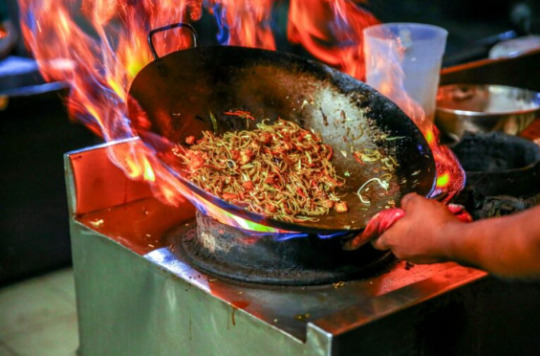
This article delves into the world of nutritious noodles, emphasizing the various options available and their nutritional benefits. It covers a variety of nutritious noodles, including whole grain, legume-based, and vegetable noodles, as well as soba, shirataki, and kelp noodles. Each type of noodle provides unique benefits, such as high fiber and protein content or low calories and carbohydrates.
The article also emphasizes the nutritional value of these noodles, highlighting macronutrients such as protein and fiber, as well as vitamins and minerals. It states that whole wheat pasta, brown rice noodles, and soba noodles are high in protein, but whole wheat pasta, quinoa noodles, and shirataki noodles are high in fiber. It also emphasizes the benefits of whole wheat pasta in terms of iron, B vitamins, and magnesium.
The article discusses dietary considerations while choosing healthful noodles, such as gluten-free or low-carb options for those with special dietary needs. It discusses how the glycemic index of the noodles affects blood sugar levels and recommends using whole-grain or alternative flour noodles to control blood sugar.
Finally, the essay includes some methods for preparing and cooking healthful noodles. It recommends selecting the appropriate sort of noodle depending on personal preferences and dietary requirements. Overall, the article's goal is to assist readers make informed decisions about including nutritious noodles into their meals based on their nutritional needs and preferences.
Introducing the world of healthy noodles creates a maze of options, each with unique nutritional benefits and culinary pleasures.
0 notes
Text

Are you looking to add another option to your diet, especially if you're dealing with diabetes? Consider keto bread—a flavorful and potentially healthy choice for individuals with diabetes. Keto bread is specially designed to reduce carbohydrate intake and mitigate spikes in blood sugar levels. Instead of using traditional wheat flour, keto bread is often made from ingredients like almond flour, coconut flour, or flaxseed meal, which tend to cause fewer sudden spikes in blood sugar. One of the strengths of keto bread for individuals with diabetes lies in its ability to better control blood sugar levels. Rather than causing a sharp increase in blood sugar and prompting insulin secretion, keto bread can help maintain more stable blood sugar levels after consumption. Additionally, keto bread is typically rich in fiber and healthy fats, which are beneficial for heart health and may play a significant role in weight management and prolonging satiety after meals.
Key Takeaways:
Keto bread is a good option for individuals with diabetes due to its lower carb content, higher fiber, and protein, which can help stabilize blood sugar levels.
Choosing low-carb bread alternatives with specific targets, such as 15g of total carbohydrate, at least 2g of fiber, and 2g of protein or more per slice, can be beneficial for managing blood sugar.
Monitoring blood sugar response to keto bread and experimenting with other low-carb bread options can help individuals with diabetes better control their blood sugar levels.
I. Factors to Consider When Choosing Keto Bread
Assuming you are seeking an additional option for your diet, especially if you're dealing with diabetes, consider keto bread, a flavorful and potentially healthy choice for individuals with diabetes. Keto bread is specially designed to reduce carbohydrate intake and mitigate spikes in blood sugar levels. Instead of using traditional wheat flour, keto bread is often made from ingredients like almond flour, coconut flour, or flaxseed meal, which tend to cause fewer sudden spikes in blood sugar.
1.1. Evaluating Carbohydrate Content and Quality
Carbohydrate intake is a crucial factor to consider when choosing the best keto bread for diabetics. Opt for keto bread with lower net carbs, as it indicates a higher fiber content that can help stabilize blood sugar levels post-consumption.
1.2. Analyzing Protein and Fiber Ratios for Optimal Blood Sugar Control
The protein and fiber content of keto bread play a pivotal role in managing blood sugar levels effectively. The combination of adequate protein and fiber can contribute to prolonged satiety after meals and assist in stabilizing blood sugar fluctuations.
Consider incorporating keto bread into your diet to potentially benefit from its lower carbohydrate intake, higher fiber and protein content, and overall impact on blood sugar levels. Perceiving the nuanced factors of carbohydrate quality, protein ratios, and fiber content can guide you in selecting the optimal keto bread for your diabetic dietary needs.
II. The Glycemic Index: A Tool for Selecting Diabetic-Friendly Bread
2.1. Definition and Importance of the Glycemic Index
With the glycemic index being a crucial tool in managing diabetes, understanding its significance is key. The glycemic index measures how specific foods impact blood sugar levels after consumption. Foods with a low glycemic index lead to a slower rise in blood sugar levels, which is beneficial for individuals with diabetes. By selecting foods with a lower glycemic index, such as keto bread, you can potentially regulate your blood sugar levels more effectively.
2.2. Tips on Reading Labels and Understanding Glycemic Load
To make informed decisions when choosing bread for diabetes management, it's vital to read labels and comprehend the glycemic load. The glycemic load takes into account the glycemic index of a food and the amount of carbohydrates consumed, providing a more accurate picture of its impact on blood sugar levels.
When opting for bread, opt for options with a lower glycemic load to help maintain stable blood sugar levels throughout the day.
Check the glycemic index and load on bread labels for better decision-making.
Focus on lower glycemic load options to avoid drastic blood sugar fluctuations.
III. Taste and Texture: Finding a Keto Bread You Enjoy
3.1. The Influence of Ingredients on Palatability
Ingredients play a crucial role in the palatability of keto bread. The use of almond flour, coconut flour, flaxseed meal, and other low-carbohydrate, high-fiber ingredients can greatly impact the taste and texture of the bread. These ingredients not only provide a unique flavor profile but also contribute to the overall health benefits of the bread, making it a suitable option for individuals with diabetes. The right combination of ingredients can enhance the eating experience and make keto bread a satisfying choice for those looking to manage their blood sugar levels.
3.2. Experimenting with Different Brands and Recipes
Keto bread offers a wide range of options when it comes to brands and recipes. Experimenting with different brands and recipes can help you find a keto bread that suits your taste preferences and dietary needs. Some brands may use specific ingredients or baking techniques that result in a softer texture or a more pronounced flavor profile. Trying out various brands and recipes allows you to discover which keto bread aligns best with your palate and provides the most enjoyable eating experience. With the right choice, you can enjoy the benefits of keto bread while savoring a delicious and satisfying slice.
IV. Practical Tips for Including Keto Bread in Your Diabetic Diet
For individuals looking to incorporate keto bread into their diabetic diet, there are several practical tips to keep in mind. Consider choosing keto bread that is made from low-carbohydrate and higher-fiber starches such as almond flour, coconut flour, or flaxseed meal. Look for options with a lower net carbohydrate count and higher protein content for better blood sugar control. Remember to pair keto bread with other nutrient-dense foods like lean proteins, healthy fats, and non-starchy vegetables for a well-rounded meal.
The versatility of keto bread allows for creative meal options, such as using it for sandwiches, toast, or as a base for healthy pizzas. Experiment with different toppings and fillings to keep your meals exciting and satisfying. The key is to balance your intake of keto bread with a variety of nutrient sources to support overall health and blood sugar management.
Balancing Keto Bread with Other Nutrient Sources
Practical Tips for Including Keto Bread in Your Diabetic Diet
Are you seeking an additional option for your diet, especially if you're dealing with diabetes? Consider keto bread—a flavorful and potentially healthy choice for individuals with diabetes. Keto bread is specially designed to reduce carbohydrate intake and mitigate spikes in blood sugar levels. Instead of using traditional wheat flour, keto bread is often made from ingredients like almond flour, coconut flour, or flaxseed meal, which tend to cause fewer sudden spikes in blood sugar. One of the strengths of keto bread for individuals with diabetes lies in its ability to better control blood sugar levels. Rather than causing a sharp increase in blood sugar and prompting insulin secretion, keto bread can help maintain more stable blood sugar levels after consumption. Additionally, keto bread is typically rich in fiber and healthy fats, which are beneficial for heart health, and may play a significant role in weight management and prolonging satiety after meals.
Optimize Your Diabetes Diet with Keto Bread: A Lower-Carb Alternative
On the whole, keto bread presents a promising option for individuals managing diabetes by offering a lower carbohydrate alternative that can help stabilize blood sugar levels. Using alternative ingredients like almond flour and coconut flour,
keto bread reduces the risk of sudden spikes in blood sugar, providing a more controlled response. Its high fiber and healthy fat content not only support heart health but also aid in weight management and promote feelings of fullness after meals. Consider incorporating keto bread into your diet as part of a balanced approach to managing diabetes.
FAQ
Q: Why is keto bread a good option for individuals with diabetes?
A: Keto bread is a good option for individuals with diabetes because it is lower in carbohydrates, higher in fiber and protein, and has a lower glycemic index. These characteristics help stabilize blood sugar levels and reduce post-meal blood sugar spikes.
Q: What are some key ingredients in keto bread that make it beneficial for people with diabetes?
A: Key ingredients in keto bread that make it beneficial for people with diabetes include almond flour, coconut flour, flaxseed meal, and other low-carbohydrate, higher-fiber starches. These ingredients contribute to the lower carb content, higher fiber content, and slower impact on blood sugar levels.
Q: How can individuals with diabetes optimize their use of keto bread in their diet?
A: Individuals with diabetes can optimize their use of keto bread by choosing options that have around 15g of total carbohydrates, at least 2g of fiber, and aim for 2g of protein or more per slice. It's also important to monitor blood sugar responses post-meal and work with a healthcare provider to incorporate keto bread effectively into a balanced diet plan.
CLICK HERE TO KNOW MORE >>>

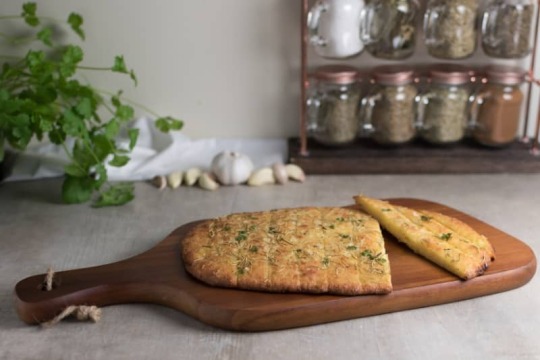




0 notes